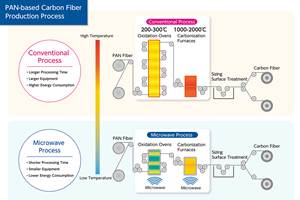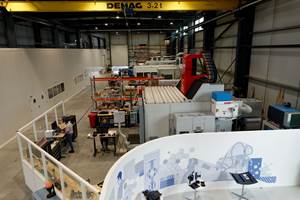New target of carbon emissions standards: Heavy-duty trucks
New proposed emissions standards in the US are designed to cut carbon pollution from heavy-duty trucks and could expand the transportation lightweighting segment of the composites industry.

In a move that could help expand the reach of composite fabrication a little more in the transportation sector, the US Environmental Protection Agency (EPA) and the US National Highway and Traffic Safety Administration (NHTSA) have jointly proposed standards for medium- and heavy-duty vehicles that would improve fuel efficiency and cut carbon pollution. The standards would cover model years 2021-2027, and apply to semi-trucks, pickup trucks, and all types and sizes of buses and work trucks. Standards for trailers would start in model year 2018.
What, exactly, the proposed standards are is difficult to discern as official news from EPA and NHTSA does not provide details. However, the net benefit of the standards, if they become regulations, are clearly outlined. First, the agencies point out:
- Heavy-duty trucks are the second largest and fastest growing segment of the US transportation sector in terms of emissions and energy use.
- The trucking industry hauls about 70% of all freight in the US.
- Medium- and heavy-duty vehicles currently account for about 20% of greenhouse gas (GHG) emissions and oil use in the US transportation sector, but are only about 5% of the vehicles on the road.
- Globally, GHG emissions from heavy-duty vehicles are growing rapidly and are expected to surpass emissions from passenger vehicles by 2030.
Second, the agencies say the proposed regulations would have this impact:
- The program would cut carbon pollution by about 1 billion metric tons. This is roughly equivalent to the GHG emissions associated with the electricity and power use from all US residences for one year
- The program would save approximately 1.8 billion barrels of oil or 75 billion gallons of fuel over the lifetime of the vehicles subject to these standards. The oil savings would exceed a year’s worth of US imports from the Oil Producing and Exporting Countries (OPEC)
- In 2027 when the standard is fully phased in, heavy-duty vehicles across all classes would achieve up to the following CO2 emissions and fuel use reductions: 24% for combination tractors designed to pull trailers and move freight when compared to Phase 1 standards; 8% for trailers when compared to an average model year 2017 trailer; 16% for vocational vehicles when compared to Phase 1 standards; 16% for pick-up trucks and light vans when compared to Phase 1 standards
Finally, and more broadly, these are the societal impacts of the proposed regulations:
- The program would save vehicle owners $170 billion in fuel costs over the lifetime of the vehicles sold.
- When fuel savings bring down the costs of transporting goods, the average household could save nearly $150 a year by 2030 and $275 by 2040 assuming all savings and costs are passed through to consumers (emphasis added).
- In total, the program would result in about $230 billion in net benefits to society over the lifetime of vehicles sold under the program. This includes fuel savings, carbon reductions, health benefits, energy security benefits, along with travel benefits, and refueling benefits.
- The benefits to society outweigh costs over the lifetime of vehicles sold under the program by about 10:1.
What all this means for the composites industry remains to be seen, but similar measures in Europe applied to passenger cars has stimulated substantial pursuit of lightweighting options that could, conceivably, be applied to heavy-duty trucks as well.
Related Content
Bio-based acrylonitrile for carbon fiber manufacture
The quest for a sustainable source of acrylonitrile for carbon fiber manufacture has made the leap from the lab to the market.
Read MoreMicrowave heating for more sustainable carbon fiber
Skeptics say it won’t work — Osaka-based Microwave Chemical Co. says it already has — and continues to advance its simulation-based technology to slash energy use and emissions in manufacturing.
Read MorePlant tour: Daher Shap’in TechCenter and composites production plant, Saint-Aignan-de-Grandlieu, France
Co-located R&D and production advance OOA thermosets, thermoplastics, welding, recycling and digital technologies for faster processing and certification of lighter, more sustainable composites.
Read MoreComposites end markets: Electronics (2024)
Increasingly, prototype and production-ready smart devices featuring thermoplastic composite cases and other components provide lightweight, optimized sustainable alternatives to metal.
Read MoreRead Next
Developing bonded composite repair for ships, offshore units
Bureau Veritas and industry partners issue guidelines and pave the way for certification via StrengthBond Offshore project.
Read MorePlant tour: Daher Shap’in TechCenter and composites production plant, Saint-Aignan-de-Grandlieu, France
Co-located R&D and production advance OOA thermosets, thermoplastics, welding, recycling and digital technologies for faster processing and certification of lighter, more sustainable composites.
Read More“Structured air” TPS safeguards composite structures
Powered by an 85% air/15% pure polyimide aerogel, Blueshift’s novel material system protects structures during transient thermal events from -200°C to beyond 2400°C for rockets, battery boxes and more.
Read More

















.jpg;maxWidth=300;quality=90)







